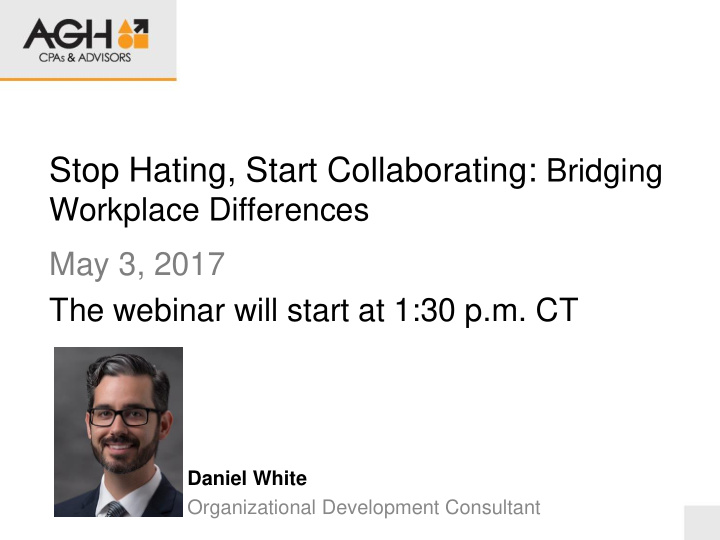



Stop Hating, Start Collaborating: Bridging Workplace Differences May 3, 2017 The webinar will start at 1:30 p.m. CT Daniel White Organizational Development Consultant
Administration If you need HR or CPE credit, please participate in all polls throughout the presentation.
Administration A recording of today’s webinar will be emailed for your reference or to share with others.
Administration For best quality, call in by phone instead of using your computer speakers.
Administration To ask questions during the presentation, use the questions box on the right side of your screen.
About the Speaker Daniel White Organizational Development Consultant Expertise in strategic planning, leadership development and employee engagement Experience teaching masters-level courses in organizational development
Learning Objectives Recognize the benefits of working with different view points. Identify potential barriers to collaboration. Learn the steps of a process to bridge differences and build trust. Understand how to translate the process into different situations.
Poll #1
Ways to Be Different
Activity: Identifying Differences
Diversity Defined A visible (gender, ethnicity, etc.) dimension that differentiates one group of people from another.
Diversity Defined A visible (gender, ethnicity, etc.) or invisible A visible (gender, ethnicity, etc.) or invisible (religion, thinking style, disability, etc.) (religion, thinking style, disability, etc.) dimension that differentiates one group of dimension that differentiates one group of people from another. people from another.
Iceberg http://www.brookgraham.com/WhatWeDo/Iceberg.aspx
Poll #2
Why Embrace Our Differences?
THE WORLD IS CHANGING
Trends
Politics Pew: Gallup: 86% 77% believe we are believe the US is more politically split over the divided than the most important past. values.
Employment Trends Younger
Generations Gen Y is the largest generation in the workforce.
Generations By 2025: 75% of workers will be Gen Y.
Employment Trends Younger Multicultural
Multicultural 2016: 1 in 4 were minorities.
Multicultural 2016: 2050: 1 in 4 1 in 2 were will be minorities. minorities.
Multicultural 2050: No ethnic majority
Employment Trends Younger Multicultural Women
Women
Benefits of Diversity & Collaboration Increased creativity Better end result More representative of population Connect with changing population
Cognitive Diversity
Potential Barriers to Collaboration
Mindsets • “Better than others”
Mindsets • “Better than others” • Don’t like change
Mindsets • “Better than others” • Don’t like change • Don’t see the need for diversity
Mindsets • “Better than others” • Don’t like change • Don’t see the need for diversity • Don’t like those different (the enemy)
Mindsets • “Better than others” • Don’t like change • Don’t see the need for diversity • Don’t like those different (the enemy) • Don’t have time
How to Bridge the Gap
Stages of Diversity Competence
Stages of Diversity Competence Denial
Stages of Diversity Competence Polarization Denial
Stages of Diversity Competence Minimization Polarization Denial
Stages of Diversity Competence Acceptance Minimization Polarization Denial
Stages of Diversity Competence Adaptation Acceptance Minimization Polarization Denial
Poll #3
How do we move toward adaptation?
The Process Understand the other person.
The Process Understand the other person. Discover common ground.
The Process Understand the other person. Discover common ground. Make a connection.
The Process Understand the other person. Discover common ground. Make a connection. Adapt your style.
The Process In Detail
Understand the Other Person • Get to know them. • Research his or her background & history. • Understand his or her intent. • What are some possible reasons the person might believe that? • If in doubt, ask.
Discover Common Ground • What common background do you have? • What common interests or hobbies do you share? • What common desires do you have?
Make a Connection • Ask the person questions. • Show interest in things the person cares about. • Small talk • Go to lunch and don’t talk work. • Work on a work project together. • Go to an event outside work together.
Adapt Your Style • Know what the person would prefer to do. • Express your desire to adapt. • Meet the person halfway (or more).
Applying the Process
IDEOLOGIES
Sports
Politics
Health
Religion/Ethics
Ideologies Understand the person’s intent.
GENERATIONS
Multiple Generations https://usflearn.instructure.com/courses/1177483/pages/generations-2-multiple-generations-in-the-workplace
Poll #4
Example – Dress Code
Is it a business necessity? (Could it cost us a customer, money, or a foot?)
Example – Work Ethic
Helping Others to Collaborate
Reasons Not A Team Player • Selfish/Don’t care about others
Reasons Not A Team Player • Selfish/Don’t care about others • Doesn’t f eel valued/appreciated
Reasons Not A Team Player • Selfish/Don’t care about others • Doesn’t f eel valued/appreciated • Frustrated by others’: • Work style • Quality standards • Personality
Helping Others • Identify the real issue.
Helping Others • Identify the real issue. • Don’t let it fester.
Helping Others • Identify the real issue. • Don’t let it fester. • Help them understand others’ intentions.
THE BIG IDEA
The Big Idea The issue isn’t about working with different (generations / ethnicities / ideologies) – it’s about understanding and valuing people.
REVIEW
Review – The Need Society is rapidly becoming more diverse and divided.
Review – The Process Understand the other person. Discover common ground. Make a connection. Adapt your style.
Poll #5
Questions?
Thank you! Daniel White Organizational Development Consultant daniel.white@aghlc.com www.linkedin.com/in/danielwilliamwhite @dw_white 316.291.4017
Recommend
More recommend